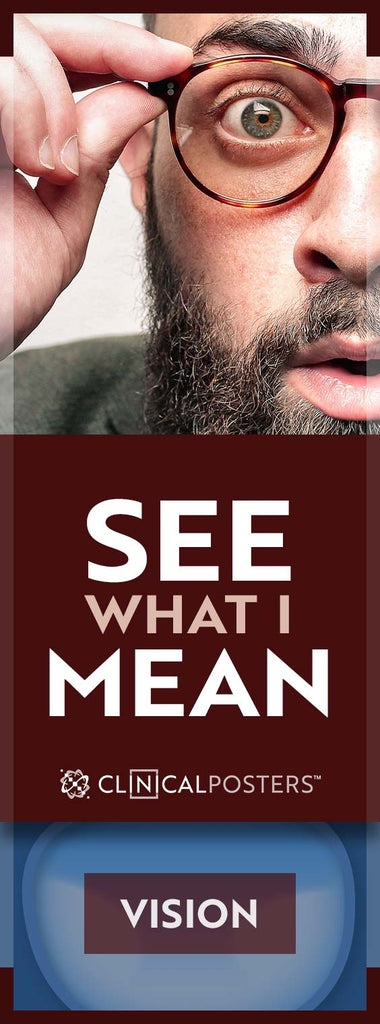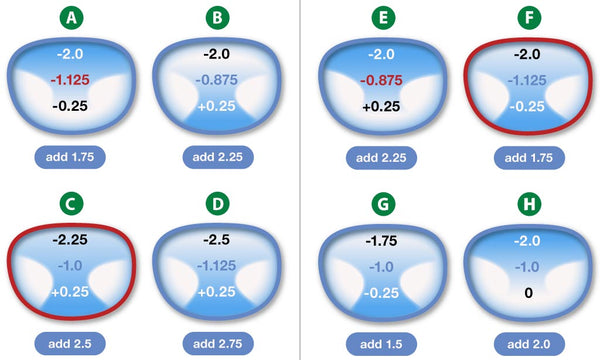As adults reach the age of 40, deteriorating vision hinders the ability to focus at a comfortable reading distance. Learn how progressive lenses differ from bifocals.
Near- and Far-Sighted
Though vision can deteriorate at any age, as adults reach the age of 40, the eye lens stiffens. This hinders the ability to focus at a comfortable reading distance. [1] The blurring, called presbyopia, can occur among people who are nearsighted (myopia) or farsighted (hyperopia).
One solution is to wear low half-oval reading glasses in conjunction with contact lenses for distance. Another solution is to have multiple glasses, each with different prescriptions for distance, intermediate, and reading. More elegant solutions involve multifocal progressive eyeglasses or contact lenses. Progressive contact lenses have one prescription in the central part of the lens and another at the outer regions. [2]

Multifocal Bifocal Prescriptions
Bifocals have two different fixed prescriptions. The lens may be divided in half with a distinct horizontal line or a smaller semi-circle reading portion can be inserted. Bifocals (or trifocals) provide the most consistent multifocal prescriptions. In a short time, the wearer becomes accustomed to lowering the head to view the ground and viewing through the lower area for reading.
Video: 9 Tips On How To Buy Prescription Glasses
Occupational bifocals and trifocals are available: a computer user often has a fixed intermediate distance (within 19 inches) for the display and a closer manuscript; public speakers need to read notes on a podium while also viewing an audience; automobile mechanics must read small measurements on tools, drive, and work at an intermediate overhead distance; golfers may require an off-center near vision inset. [3]
Multifocal Progressive Prescriptions
Progressive lenses blend from reading at the bottom to distance at the top without a visible line. Thus, they actually contain many prescriptions. (Side distortion decreases peripheral acuity. Patients become accustomed to making necessary head adjustments to compensate.) As the variance between top and bottom prescriptions increases, the intermediate vision is more dramatically altered.
If the prescription is -2.0 (distance) and +0.25 (reading) then the intermediate between the two is -0.825. This is much less correction than the prescribed -2.0 so the wearer may occasionally tilt his head down to access the stronger zone at the upper rim of the glasses.
Ideally, the intermediate portion of the lens falls slightly below the iris. Depending upon the style and weight of the glasses, they may slide down, particularly when perspiring, thus altering optimum alignment. With progressive eyewear in mind, an optometrist may modify the minimum and maximum prescription so the graduated sweet-spot offers clarity.

Eyeglass prescriptions indicate compromises of multifocal lens. Goal is for even blue tone for most clarity. Peripheral vision falls out of focus. The center is an average between quarter-increment top (distance) and bottom (reading) prescriptions.
Figure 1 (Left): Here is why a good optometrist is required to prescribe eyeglasses. In (A), the patient’s vision is corrected to 20/10 with -2.0 prescription for distance and -1.125 intermediate. However, the reading zone is generally blurry for objects beyond 18 inches. In figure (B), the reading zone is adjusted for optimum clarity but at -0.875, the intermediate/
Figure 2 (Right): Now let’s assume (E) is the 20/10 corrected distance prescription and there is a desire to improve the reading. Limited to increments of 0.25, the reading is improved with a -0.25 prescription in figure (F). This softens the intermediate but corrects to 20/20. Figure (G) sacrifices distance and figure (H) sacrifices reading. Progressive lenses that narrow the intermediate range would enhance the overall prescription. A second pair of eyeglasses like (G) would improve comfort for extended intermediate-range computer use.






